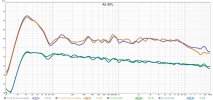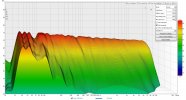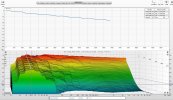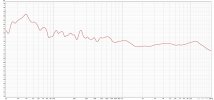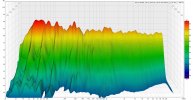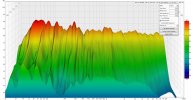I have this massive 42 Hz peak that I managed to reduce with FIR EQ, and the 14 mineral wool panels absorbed the huge reverb I had on mids and highs in my dedicated listening room (5.00 x 4.15 x 3.25 m). But still I have a massive reverb on bass that I am waiting for my supplier of panels to build them for me, tuned to 50 Hz, as I can see from the decay graph. Work in progress.
-
WANTED: Happy members who like to discuss audio and other topics related to our interest. Desire to learn and share knowledge of science required. There are many reviews of audio hardware and expert members to help answer your questions. Click here to have your audio equipment measured for free!
You are using an out of date browser. It may not display this or other websites correctly.
You should upgrade or use an alternative browser.
You should upgrade or use an alternative browser.
Share your in-room measurements?
- Thread starter thefsb
- Start date
Measurement newbie here, posting my first results. LR (Revel F36) with two HSU ULS-15mk2 subs. Audyssey corrected to 500hz. Crossover 80hz. Moving microphone centered on the MLP sofa. This system is a significant step up from my previous budget system so it sounds pretty good to my not-golden ears. I have no desire for room treatments (system in main living room, aesthetics at a premium) but am somewhat curious how much bass smoothing I might get from a mini-DSP 2x4. Curious to hear any interesting conclusions about the measurements from people who understand them better than I do. I assume 40hz is a room mode?
Attachments
Last edited:
To my eyes 40 Hz is a room mode combined with other bass boosting problems. Room modes usually have high Q (they are sharp points in FR graphs). Hard walls boost low frequencies a lot, which seems may be your other issue.Measurement newbie here, posting my first results. LR (Revel F36) with two HSU ULS-15mk2 subs. Audyssey corrected to 500hz. Crossover 80hz. Moving microphone centered on the MLP sofa. This system is a significant step up from my previous budget system so it sounds pretty good to my not-golden ears. I have no desire for room treatments (system in main living room, aesthetics at a premium) but am somewhat curious how much bass smoothing I might get from a mini-DSP 2x4. Curious to hear any interesting conclusions about the measurements from people who understand them better than I do. I assume 40hz is a room mode?
You would most certainly benefit from any dsp that would allow you to independently tune each channel, but I wonder why isn't Audyssey doing it already... You have already invested on good sound system, so if you decide to buy a separate dsp unit, don't buy the cheapest one or you might get additional hiss and raised distortion levels. MiniDSP SHD is a good device and 2x4 HD model is less, but also sufficient. If at all possible, I'd suggest you try first with some free alternative, like a computer software (such as Equalizer APO) to see what kind of difference it can make.
Also moving the subs a little further away from and wall is another option, but can introduce other problems.
Also a waterfall plot with at least 80 dB vertical range would tell a lot about your room conditions. Your FR graphs looks very good above 100 Hz. You don't have any nulls, which is rare when many speakers.
Thanks, you have given me some good things to mull over. Next time I find time to have a measurement session I'll get the waterfalls. I also wonder why Audyssey doesn't seem to tame that big 40hz peak (well, it THINKS it has done so based on it's "after" graph which seems to be highly optimistic).To my eyes 40 Hz is a room mode combined with other bass boosting problems. Room modes usually have high Q (they are sharp points in FR graphs). Hard walls boost low frequencies a lot, which seems may be your other issue.
You would most certainly benefit from any dsp that would allow you to independently tune each channel, but I wonder why isn't Audyssey doing it already... You have already invested on good sound system, so if you decide to buy a separate dsp unit, don't buy the cheapest one or you might get additional hiss and raised distortion levels. MiniDSP SHD is a good device and 2x4 HD model is less, but also sufficient. If at all possible, I'd suggest you try first with some free alternative, like a computer software (such as Equalizer APO) to see what kind of difference it can make.
Also moving the subs a little further away from and wall is another option, but can introduce other problems.
Also a waterfall plot with at least 80 dB vertical range would tell a lot about your room conditions. Your FR graphs looks very good above 100 Hz. You don't have any nulls, which is rare when many speakers.
If you saved the measurement from last time, you can open it to generate the waterfall.Thanks, you have given me some good things to mull over. Next time I find time to have a measurement session I'll get the waterfalls. I also wonder why Audyssey doesn't seem to tame that big 40hz peak (well, it THINKS it has done so based on it's "after" graph which seems to be highly optimistic).
If you look at the previous post of your post, you'll see a waterfall graph. Matias has flattened the frequency response, but still has massive sustain on frequencies below 100 Hz. That basically means that those frequencies echo around the room while higher frequencies have already decayed. That will degrade perceived sound quality.
I can't generate a waterfall from my RTA (moving microphone) data but I did have some sweep measurements from a previous session. I included both a 300ms and 600ms version. Any conclusions you can draw from these would be greatly appreciated. For room acoustics context, the room is 16 feet (back to front) x 22 (side to side) with 12 foot ceilings and is open on the L side to the adjacent room.If you saved the measurement from last time, you can open it to generate the waterfall.
If you look at the previous post of your post, you'll see a waterfall graph. Matias has flattened the frequency response, but still has massive sustain on frequencies below 100 Hz. That basically means that those frequencies echo around the room while higher frequencies have already decayed. That will degrade perceived sound quality.
Attachments
Last edited:
Your room is not bad, 300 ms bass has decayed quite well in line with higher frequencies. This waterfall shows a few room modes as well as possible nulls, but your Audyssey has probably worked on them by shifting phase.I can't generate a waterfall from my RTA (moving microphone) data but I did have some sweep measurements from a previous session. I included both a 300ms and 600ms version. Any conclusions you can draw from these would be greatly appreciated. For room acoustics context, the room is 16 feet (back to front) x 22 (side to side) with 12 foot ceilings and is open on the L side to the adjacent room.
When doing manual room mode correction, I suggest turning off any automated dsp and run them again after room modes have been dealt with.
I would try a few filters and then reiterate.
40 Hz, Q 4, -5 dB
65 Hz, Q 4, -5 dB (this is tricky because it phases out and manifests slightly higher. would need much more testing)
110 Hz, Q 4, -5 dB
250 Hz, Q 4, -5 dB
When the room modes are killed, I would use a shelf filter to lower bass response, but this depends on your personal preference.
LShelf 67 Hz, Q 1, -3 dB
With REW you could simulate the filters, but you need to also measure to confirm. When doing this manually, you need to be prepared for multiple iterations and progressively test filters to see how they affect. The effect of a filter is not always linear, because it room modes can die out with less than what they do and phase shift of the filters can affect them as well. The filters I've provided above are just off the hat values from looking at the graphs, but should have good impact.
Your room is not bad, 300 ms bass has decayed quite well in line with higher frequencies. This waterfall shows a few room modes as well as possible nulls, but your Audyssey has probably worked on them by shifting phase.
When doing manual room mode correction, I suggest turning off any automated dsp and run them again after room modes have been dealt with.
I would try a few filters and then reiterate.
40 Hz, Q 4, -5 dB
65 Hz, Q 4, -5 dB (this is tricky because it phases out and manifests slightly higher. would need much more testing)
110 Hz, Q 4, -5 dB
250 Hz, Q 4, -5 dB
When the room modes are killed, I would use a shelf filter to lower bass response, but this depends on your personal preference.
LShelf 67 Hz, Q 1, -3 dB
With REW you could simulate the filters, but you need to also measure to confirm. When doing this manually, you need to be prepared for multiple iterations and progressively test filters to see how they affect. The effect of a filter is not always linear, because it room modes can die out with less than what they do and phase shift of the filters can affect them as well. The filters I've provided above are just off the hat values from looking at the graphs, but should have good impact.
Thanks so much for the suggestions! I may not find time for experimenting for a while but will report back when I do.
- Joined
- Jun 5, 2020
- Messages
- 4,816
- Likes
- 3,752
Yes. Desktop reflection mostly affects the midrange.Genelec 8010 + 7040 sub with untreated room. What could be cause of that 700 hz+ dip? 8010 are on tilted stands at wooden computer desk.
Its pretty annoying. Anyway to fix?
View attachment 209529
Might not just be your room. The dip is definitely there in the direct sound:Anyway to fix?
I suggest you enable these two PEQ filters and remeasure:
Filter 1: ON PK Fc 990 Hz Gain 2.5 dB Q 5
Filter 2: ON PK Fc 1143 Hz Gain -1.5 dB Q 9
Might not just be your room. The dip is definitely there in the direct sound:
I
Thanx!Might not just be your room. The dip is definitely there in the direct sound:
View attachment 209605
I suggest you enable these two PEQ filters and remeasure:
Filter 1: ON PK Fc 990 Hz Gain 2.5 dB Q 5
Filter 2: ON PK Fc 1143 Hz Gain -1.5 dB Q 9
I tried to remeasure with reference Sound ID correction enabled and it look like this, still some dip in 36hz, 1340hz:
Last edited:
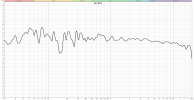
My room is an acoustic mess: between the speakers, there sits a big shelf that complicates SBIR, as is visible from the big nulls in bass. This MMM measurement is after a 7-band IIR room EQ. Despite the ugly looking bass spectrum, this is now the best sound that I had of all my previous setups. The above graph belongs to the following speaker:
The replacement of the low Mms, highly efficient Faital 12PR320 did change a lot, most notably, the plate amp is running much hotter as it draws more Watts. Compared to the Faital setup, of which you find the in-room response in the second link, the bass of the PHL 3411 10-inch driver has more meat. Yet, its response is very controlled, neutral, potent. I love it.
Last edited:
- Joined
- Jun 5, 2020
- Messages
- 4,816
- Likes
- 3,752
It's not likely that a shelf would be affecting your bass SBIR. More likely you have a path length to the floor, ceiling, or nearby wall which corresponds to a 1/2 wave cancellation in that range (3.75 feet TO and FROM a hard surface like a floor = 7.5 feet = 150 Hz)
I don't see any nulls. A lower amount of smoothing might reveal them.between the speakers, there sits a big shelf that complicates SBIR, as is visible from the big nulls in bass.
Quite the dramatic tilt you got there with the Metas, What's up?My armchair system, KEF LS50 Meta plus 10" subwoofer and equalisation just below 200 Hz:
View attachment 211227
My desktop system, KEF LS50 Anniversary with full range equalisation:
View attachment 211228
- Joined
- Jan 15, 2020
- Messages
- 6,905
- Likes
- 16,956
A bit higher room absorption in the last octave, otherwise its very close to the "Bob Katz target":Quite the dramatic tilt you got there with the Metas, What's up?
A bit higher room absorption in the last octave, otherwise its very close to the "Bob Katz target":
View attachment 212071
What’s the bob Kats target?
How far are you sitting from them? Cause i never seen a speaker with constant directivity experiencing a more aggressive tilt just because the room has more absorption.
Similar threads
- Replies
- 18
- Views
- 1K
- Replies
- 44
- Views
- 3K
- Replies
- 2
- Views
- 248
- Replies
- 21
- Views
- 2K
- Replies
- 4
- Views
- 593

